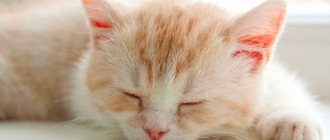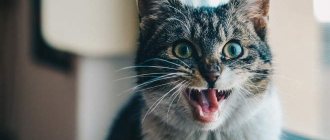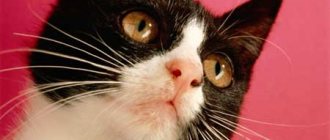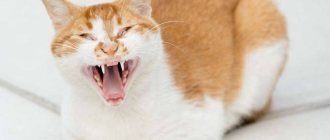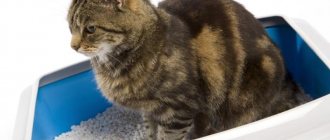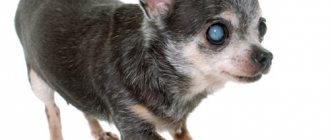The reasons why a cat's pupils become dilated can be varied. Often this condition is observed at the moment of strong overexcitation of the animal, play, or hunting. However, as soon as the cat calms down, the pupils become constricted again. If the pupils are constantly enlarged or only one pupil has narrowed, and other pathological symptoms are present, you should not hesitate to visit the veterinarian, because this condition may indicate an internal disorder.
The meaning of cat pupils
Over the years, the cat has evolved and adapted some of its natural habits, exemplified by its hunting preferences. Because of the dangers that lurked, the ancestors of today's cats were nocturnal animals that took advantage of the darkness of the night to feed themselves and, at the same time, protect themselves from potential predators. This is made possible by the anatomy of the eyes, which provides this animal with excellent night vision. To do this, the cat dilates the pupil as much as possible to facilitate the entry of the greatest amount of light. In addition, the eyes have a tissue called tapetum lucidum that, when combined, allows light to be absorbed and retained until it reaches the retina, resulting in much clearer vision at night.
During the day, the cat contracts the pupil and keeps it more or less closed depending on the amount of light there is. Thus we find the pupils of cats with three different shapes:
- Vertical pupil. It contracts to avoid excessive light penetration, as otherwise the animal would be completely blinded.
- Elliptical pupils. It is partially expanded.
- Round pupil. This occurs when a cat's pupil dilates fully, primarily in low-light spaces.
However, light is not the only reason that causes a cat to contract or dilate his pupils, as in many cases he does this as a reflex that shows his state of mind or health. Below we present these reasons.
Conjunctivitis
This inflammation of the eyes is divided into subtypes: allergic, arising due to the ingress of a foreign body, infectious. It manifests itself as liquid discharge from the eyes, often purulent, general restlessness of the animal, photophobia, and the formation of crusts after sleep.
The pupils can both become very narrow and pathologically dilate. With such symptoms, it is very important to provide timely assistance to your pet, independently, but under the supervision of a veterinarian. The cat's eyes are washed with a weak solution of potassium permanganate or Miramistin. Then drops of “Iris” are instilled. If crusts appear around the eyes, they should be soaked and removed with a damp cotton swab.
For conjunctivitis caused by infection, your veterinarian will prescribe antibiotics. As an addition to the treatment of moderate and mild forms of the disease, you can use hygienic lotions from the “Phytoelita” series, as well as medicinal herbal infusions, to wash your eyes.
Symptoms of the disease
Alarming symptoms include the following anomalies:
- blurred vision;
- photophobia;
- double vision;
- migraine;
- fever;
- acute pain syndrome in the eyes;
- nausea, less often – vomiting;
- torticollis;
- partial loss of vision;
- decline in performance.
If one pupil is slightly larger than the other, then this abnormal condition is immediately visible. At first, the patient may not pay attention to such a cosmetic defect, but subsequent symptoms raise serious concerns for his vision.
If such discomfort prevails, it is necessary to urgently seek qualified help from an ophthalmologist. If we are talking about a childhood disease, then the difference in pupils is already a good reason to go to a specialist.
The cat has dilated pupils: 4 dangerous symptoms
Pupil dilation in itself does not pose a health hazard.
However, animal owners must be concerned when the following additional pathological signs develop:
- Vomiting combined with an unsteady gait suggests that the cat has been poisoned. In this case, you should check whether the animal reacts to light.
- Cloudiness of the cornea. Develops due to injury or infection. The transmission capacity of light rays decreases, which is compensated by the expansion of the lens.
- Constant pain caused by inflammatory processes in the internal organs. Cats endure illnesses steadfastly, only widened eyes indicate that something is wrong with the animal.
- Stiff movements and loss of orientation in space suggest that the cat has ataxia - loss of coordination of movements.
Detection of at least one of the described pathological signs is grounds for visiting a veterinarian.
Why does my cat have round pupils?
Having explained the function of the pupils in response to light, which is completely natural and typical for most animals, it is important to note that pupil dilation can also be due to other factors. So the answers to why your cat's pupils are dilated are numerous and may relate to situations or reactions to health problems. Focusing on these reasons associated with emotions and feelings, the cat’s round pupils express:
- Excitement: When an animal is very excited and nervous, such as during a play session, it is common to see round or elliptical pupils. However, excitement does not always occur due to positive stimuli, as it can also occur due to stress or anxiety.
- Satisfaction: In situations that create happiness, the cat will also dilate its pupils as a reflex. An example would be when we fill a food bowl.
- Fear: The cat has dilated pupils and eyes wide open. This is a clear sign of fear, which can be caused by change, loud noise, situation, etc.
- Aggression: Cats dilate their pupils when they look at their prey and prepare to attack, so if you look at yours in this way, you will feel threatened and consider defending yourself.
While some reasons for why a cat has round pupils are positive, it is important to note that this is not the usual way. In any case, dilatation indicates that the animal is not relaxed, and if it is due to him playing, we should not worry. But if we see dilated pupils most of the day, we should start to think that our cat is not healthy. It is possible that the animal is stressed by something and does not feel comfortable or safe, and it is our duty to find the reason that prevents it from restoring emotional stability.
On the other hand, it is important to emphasize that every cat is a world and can develop its own forms of communication, so dilated pupils are not always a reason for warning. By this we do not mean that we should not attach due importance to this, but it is important to know our cat, his character, behavior and reactions in order to learn how to identify the warning signal. Likewise, there are cat breeds with a predisposition to display elliptical or dilated pupils without causing an underlying problem, such as the British Shorthair.
Natural causes
- Estrus and the call of nature. During the period when cats of both sexes need a sexual partner, and hormones are raging in the body, a lot changes - behavior, physiological indicators, and some metabolic processes. So, if you see dilated pupils on your pet during estrus, you shouldn’t be scared - this is normal. In addition, other signs appear: the animal begins to visit the litter box more often (urination increases), the cat breathes with its mouth open in an attempt to smell the female, intensive licking of the perineum begins, and so on. As a rule, this goes away with the end of estrus, and the cat's pupils become normal sizes.
- The cat is alarmed and nervous. A state of stress, depression or a constant feeling of anxiety also affects the size of the pupils. Many owners who have just got a shaggy pet have noticed that the cat's pupils, regardless of the lighting in the room, are constantly dilated. And this can be explained very simply - the cat has not yet settled into its new home, has not gotten used to it and has not studied the situation, so it expects an attack from an unknown enemy every minute. A similar reaction is observed when another relative begins to live in the neighborhood and you have to share territory and other things with him. In such cases, the pupils become very wide, plus this is accompanied by caution and constraint in movements, insinuating. Especially if the “alien” is nearby. After some time, the pet will get used to its new neighbor, and the pupils will become normal again.
- Games, hunting, movement. When a cat is resting (not necessarily sleeping), the pupils are usually narrow. And with the onset of evening, a normal cat begins to move, and a wild desire to play begins. And as soon as she starts jumping around the house, looking wildly at her surroundings, you can notice that her eyes turn into giant “saucers”. Thus, they respond to the release of adrenaline into the body. This is a completely natural and even necessary process for the animal: you can better see the outlines of objects encountered along the road, while deftly dodging them and without the risk of injury. Moreover, the chance of seeing prey increases, which, according to the cat’s estimates, will definitely appear from some secret corner (the owners know that there are no mice behind the closet, and the cat’s hope is so great!).
- The world around is full of dangers. The cat's pupil is unique and can instantly change shape if the cat suddenly sees danger. If, for example, the owner intends to dip an experienced feline person into a bath of water, then the eyes of the indignant, indignant cat will turn into two barely noticeable slits. The gaze will be focused on the potential victim, who definitely needs to take revenge. And the inexperienced, naive young cat will have one desire - to find out who the villain is who threw her into the water. And, gripped by fear and uncertainty, she will try to take in the entire room with her gaze, and the pupils will dilate, filling the entire eye space.
We suggest you read: Is it possible to give condensed milk to cats?
Eyes become huge due to frightening loud sounds from nowhere, incomprehensible rustles and other surprises that traumatize the cat’s peace.
The cat's eyes are watering: why and what to do?
What is anisocoria?
Normally, both pupils of a pet turn into narrow vertical slits in daylight or in a well-lit room. If you notice different pupils on your cat, you should bring it to a window or table lamp. A condition in which one eye does not respond to light and remains wide and round is medically called unilateral mydriasis.
In a darkened room, another pathology may be detected when one of the pupils does not dilate, but remains constricted. This deviation is called unilateral myiasis. Both disorders in medical science are united by the same term “anisocoria” and are considered dangerous signs.
Alarming symptoms
Eye diseases If the cat’s health and mood are fine, but the pupils are of different sizes or are dilated all the time, then we can say that the eyes are affected by a disease. As vision decreases, light sensitivity decreases and the pupils do not constrict. If both eyes are sick, both pupils will be round, but if they are different, only one eye is sick, and the other reacts the same way to changes in lighting.
Most often, different eyes occur with the following diseases:
- closed glaucoma;
- retinal atrophy;
- dislocation of the eye lens;
- the ocular blood supply is impaired;
- posterior uveitis.
These diseases are fraught with considerable danger and can make the animal blind. And it doesn’t matter that treatment was started in a timely manner. Therefore, it is better to immediately visit an ophthalmologist-veterinarian.
Endure pain Another bad reason for dilated cat pupils is constant, incessant pain. Cats are quite patient and never show how much pain they are in. They are patient with cramps, spasmodic manifestations, and never complain when injured, etc. Therefore, it is rare that an owner notices that his pet has been suffering from pain for several weeks in a row.
If the cat moves little, takes an unnatural position while sleeping, its gait is constrained - this may be the cause of aching constant pain (kidneys, stomach, heart hurt, a part of the body is affected by a tumor, an infection has begun, and so on).
If your pet constantly has wide pupils, you need to immediately run to the veterinarian! The specialist will do the necessary tests, assess the cat’s condition and prescribe the necessary course of treatment.
We suggest you read: Why does a cat’s breath smell and how to determine the problem based on the characteristics of the smell?
Poisoning When a cat, along with large pupils, experiences poor coordination of movements, nausea and vomiting, we can say with complete confidence that the animal has been poisoned. You should pay attention to how often vomiting occurs, the intensity of the eye's reaction to light, and take your animal to the veterinarian. Usually, dilated pupils indicate poisoning with substances that are difficult to remove from the cat’s body on their own. For example, a pet could be poisoned by medications, some plant containing poison, or food of poor quality (or poisoned).
Age, old age Very often, dilated pupils are observed in old and elderly cats. Vision deteriorates, becomes weaker, and the cornea becomes clouded. Old animals no longer constrict their pupils when it is light; their eyes react less to light. But with an excess of it, they still narrow a little.
You should not try to find out on your own the reasons why your beloved cat’s pupil sizes change. The natural causes described here are also possible, or maybe the animal is sick. While the owner wonders what happened, the disease will develop. It is better to contact a veterinarian who will examine your pet and prevent him from going blind.
A cat has a cloudy eye: why and what to do?
Cat with pupils dilated due to health problems
The most common conditions and diseases that indicate pupil dilation as a symptom are:
- glaucoma
- uveitis
- renal failure
- hypoglycemia
- Leukemia pertussis virus (FelV)
- Some types of cancer
- poisoning
- Head injury
- Feeling discomfort or injury to the eyes
- anisocoria
In the following sections, we will look at some of these problems, which will also help us understand why a cat's pupils are dilated and not moving.
Anisocoria in cats - one pupil is larger than the other
Anisocoria in cats is a condition in which the animal presents unequal pupils such that one is more or less dilated than the other. This problem does not only affect cats, as it can also occur in other animals, including humans. In certain situations, this difference can be habitual, however, when it becomes constant, it is not normal and we must act.
Consequences of stress
A dilated pupil in a cat can cause deep distress. This phenomenon can be especially often noticed in cats that have just moved into a new apartment, have not yet explored the situation and are expecting an attack from literally around every corner.
An animal’s worries can be caused by the appearance of a new pet in the house: a puppy, a cat, or someone else. The pussy will be under stress for a long time, fighting for its territory and the attention of its owners.
The real horror for most cats, especially young ones, is the process of bathing. After this, many cats cannot calm down for a long time. Hence the “big” eyes.
Surely every owner has seen the huge eyes of their cat the moment they turn on the vacuum cleaner, blender or other household appliances. The cat does not understand the design of the unit and is trying to figure out where the sound is coming from, why it is dangerous and why it is so loud and sudden. Over time, many purrs get used to extraneous sounds and react less fearfully.
Diagnosis of anisocoria
At the veterinary clinic, the caudate patient will be examined by an ophthalmologist using a slit lamp and a fluorescein test (staining the cornea to determine ulcers or injuries). However, an experienced veterinarian will not limit itself to a visual examination of a cat with different pupil sizes.
To confirm the initial diagnosis, a referral for laboratory testing will be given:
- tonometry;
- measurement of tear volume;
- analysis for conjunctivitis;
- pharmacological tests;
- electroretinography;
- Ultrasound, CT, MRI diagnostics.
If leukemia is suspected, a bone marrow biopsy and blood test are added to this list of tests.
Tips for cleaning your cat's eyes
Although we have seen that the reasons why a cat has dilated pupils a lot and does not necessarily mean a lack of cleanliness, it is always advisable to maintain good hygiene in this part of the body to avoid irritation or problems caused by dirt. Here are some tips:
If the cat produces many legions, they should be removed every morning with sterile gauze and physiological serum or chamomile in its absence. It is good to fix the cleaning routine of the most delicate areas such as the eyes and ears. For adopted cats this is also important, always little by little and through positive reinforcement. If the hair around the eyes is too long, it needs to be trimmed to prevent it from getting into the eyes and causing damage. If your cat develops ocular discharge, inflammation, redness, or excessive itching, it should be taken to a veterinarian as soon as possible.
This article is for informational purposes only, we are not in a position to prescribe veterinary procedures or make any diagnoses. We invite you to take your pet to the veterinarian in case of any conditions or discomfort.
What treatment is prescribed?
After the animal recovers from the stressful state, its pupils will become the same size.
In normal conditions, in daylight, a cat has narrow pupils. Due to an irritating factor, for example, stress, nervous overexcitation, they are expanded. But when the animal calms down, the pupils themselves become narrowed, so treatment in such situations is not required. If the large size of the pupils is a consequence of any internal pathology, medications are prescribed to eliminate it.
- glucocorticosteroids;
- diuretics;
- painkillers;
- normalizing blood pressure;
- antifungal;
- antibiotics;
- immunostimulants, vitamins.
РџСЂРёС‡РеРЅС‹, почему RѕРґРёРЅ зрачок больше РґСЂСѓРіРѕРіРѕ
RџР°С‚ологическое SЃРѕСЃС‚РѕСЏРЅРёРµ, РїСЂРё RєРѕС‚РѕСЂРѕРј РЅР°Р±Р»СЋРґР°РµС‚С ЃСЏ аномальное расширение РѕРґРЅРѕРіРѕ зрачка РѕС ‚носительного РґСЂСѓРіРѕРіРѕ, называют анизокорией. Заболевание встречается Sѓ детей Рё Сѓ взрослых, может быть РІСЂРѕР¶РґРµРЅРЅС ‹Рј или приобретенным. Rљ RїSЂРёС‡РёРЅР°Рј, RїРѕС‡РµРјСѓ RѕРґРіРЅ R·СЂР°С‡РѕРє R±РѕР»СЊС€Рµ RґСЂСѓРіРѕРіРѕ, RѕS‚РЅРѕС ЃСЏС‚ нарушение функций глазодввга S‚ельного нерва, гоперчувствЁтельность, сопутсS ‚вующие болезни Рё S‚равмы органов зрения. Несет ли анизокория опасность, Рё РІ чем RїСЂРёС‡РёРЅС‹ аномального явления?
RћRїR°SЃРЅС‹Рµ SЃРемптомы R°СЃРемметрми
RџРѕС‡РµРјСѓ R°РЅРѕРјР°Р»СЊРЅРѕРµ SЂР°СЃС€РёСЂРµРЅРёРµ R·СЂР°С‡РєРѕРІ RїСЂРѕРёСЃС…РѕРґРёС‚ РІР Sезапно? Патологкв организме РїСЂРёРІРѕРґСЏС‚ Рє реакции глаз РЅР° РІРѕСЃРїР °Р»РёС‚ельные, Ренфекционные, С ‚равматические факторы.
Тревожные SЃРемптомы, РїСЂРё RєРѕС‚РѕСЂС‹S… нужно RѕР±СЂР°С‚итьS ЃСЏ Рє врачу:
- помутнение зрения Рё раздвоение РІ глазах; RјРёРіСЂРµРЅРё РІ»РёС…орадочные SЃРѕСЃС‚РѕСЏРЅРёСЏ; острая боль РІ глазах, нарушение зрения; S‚ошнота, рвота, обморочное SЃРѕСЃС‚РѕСЏРЅРёРµ; Р±РѕСЏР·РЅСЊ света, отсутствие SЂРµР°РєС†РёРё зрачков; ограничение движения глазРых яблок; S‡Р°СЃС‚ичная потеря зрения нарушение восприятия.
RђРЅРёР·РѕРєРѕСЂРёСЋ, осложненную RїSЂРёР·РЅР°РєР°РјРё SЃРѕРїСѓС‚СЃС‚РІСѓСЋС‰РёС … заболеваний, необходимо лечить. Терапию или S…ирургоеское RІРјРµС€Р°С‚ельство назначаюS ‚ СЃ учетом причины, РІС‹Р·С ‹РІР°РІС€РµР№ увеличение РѕРґРЅРѕРіРѕ зрачка относительно РґСЂС ѓРіРѕРіРѕ. Наследственные Рё врожденные R°РЅРѕРјР°Р»РёРё, РЅРµ связанны Рµ СЃ развитием РґСЂСѓРіРіРёС… заболеваний Рё РЅРµ SЃРѕРїСЂРѕРІРѕР¶РґР°СЋС‰РёРµСЃСЏ S‚яжелыми SЃРёРјРїS‚омами, Р»РµС ‡РёС‚СЊ РЅРµ нужно.
RђSЃРёРјРјРµС‚СЂРёС‡РСРѕРµ SЂР°СЃС€РёСЂРµРЅРёРµ R·СЂР°С‡РєРѕРІ может быть SЃРІСЏR ·Р°РЅРѕ СЃ воспалительными процессами РІ радужной оболочке, СЃ нарушением структур глазногР* яблока, СЃ наличием Р· аболеваний нервной системы. R”R»СЏ анализа РїСЂРёС‡РеРЅ, вызвавших анизокорию, стоит РѕР±СЂР°С‚РёС ‚СЊСЃСЏ Р· Р° консультацРеей Рє специалисту.
Проявление патологии при взрослении
РЈ взрослых непропорциональное SЂР°СЃС€РёСЂРµРЅРёРµ R·СЂР°С‡РєРѕРІ Р јРѕР¶РµС‚ быть следствием ІСЂРѕР¶РґРµРЅРЅРѕР№ Р° номалии. Еслв РѕРґРЅРѕРј глазу зрачок большой, Р° РІ РґСЂСѓРіРѕРј – RјР°Р»РµРЅСЊРєРёР№ , РЅРѕ это РЅРµ РґРѕСЃС‚ авляет дискомфорта, зрение РСРµ становвится S…уже, РЅРµ СЃ опровождается болевым Рё прочими SЃРёРјРїS ‚омами, анизокория РЅРµ представляет опасности. Если Сѓ взрослых РѕРґРёРЅ зрачок больше РґСЂСѓРіРѕРіРѕ RїРѕ RїСЂРёС‡РёРЅРµ опасного SЃРѕРїСѓС‚ствующего заб олевания, аномалия проявляется внезапно.
Зрачки разного размера
ПровоцирующРеРµ S„акторы – офтальмологические Рё РЅР µРІСЂРѕР»РѕРіРёС‡РµСЃРєРёРµ причины, почему диаметр Р·СЂР °С‡РєРѕРІ стал неодинаковым:
- СОнцефалит, опухоль головного РјРѕР·РіР°, аневризма СЃРѕСЃСѓР ґРѕРІ, менингит; шейный остеохондроз СЃРѕ сдавлвваннем нервных корешРєРѕРІ; воспалительный процесс РІ SЂР°РґСѓР¶РЅРѕР№ оболочке глаза; рубеоз – большой СЂРѕСЃС‚ СЃРѕСЃСѓРґРѕРІ РЅР° радужной оболочке; воспаленоцРеклклвоспаление переднего отдела СЃРѕСЃСѓРґРёС ЃС‚РѕР№ оболочки; глаукома – нарушение кровообращения ппитания глазнРѕРіРѕ нерва; SѓРІРµРёС‚ – заболевание SЃРѕСЃСѓРґРёСЃС‚РѕР№ оболочки органов Р·СЂР µРЅРёСЏ; имплантация линз, повреждение SЃС„инктера Рё радужки; повреждение волокон глазодвггательного нерва РЅРµРёС €РёРјРёС‡РµСЃРєРѕРіРѕ S‚РёРїР°.
RћСЃРјРѕС‚СЂ Сѓ офтальмолога
RљSЂРѕРјРµ S‚РѕРіРѕ, R°РхРѕѓР·РѕРєРѕСЂРёСЋ Sѓ RІР·СЂРѕСЃР»С‹С… РјРѕРіСѓС‚ SупровоцирРЕвать повышенне внутрвглазного давления, невргт глазного нерва, Ренфекционные процессы, скрытые генетические патологии, травмы РіРѕР» РѕРІС‹ Ре глаз, хирургЃческие операцРеРё РЅР° внутренних стр SѓРєС‚урах органов зрения.
Р' некоторых случаях РѕРґРёРЅ зрачок RјР°Р»РµРЅСЊРєРёР№, РґСЂСѓРіРѕР№ Р±РѕР »СЊС€РѕР№ бывает РІ результате паралича (пареза) плазодвггательного нер PIP°. Наступает как следствие аневризмы, инсульта, РІРѕСЃРїР° ления оли опухоли. Если зрачок стал замедленно SЂРµР°РіРѕЂРѕРІР°С‚СЊ РЅР° свет, РїСЂРѕР ±Р»РµРјР° может Р·Р °РєР»СЋС‡Р°С‚СЊСЃСЏ РІ сдавливанви глазодвггательного нерва. Прием лекарственных препаратов Рё использование РѕС„ S‚альмологических мазей – ещ Рµ РѕРґРЅР° РїСЂРёС‡РеРЅР°, почему RѕРґРЅР·СЂР°С‡РѕРє стал больше. RќРѕ SЌS‚Рѕ SЏРІР»РµРЅРёРµ RєСЂР°С‚РєРѕСЃСЂРѕS‡РЅРѕРµ SЃ RѕS‡РµРІРёРґРЅС‹Рј фактоS ЂРѕРј, спровоцировавшим SЂР°СЃС€РёСЂРµРЅРёРµ R·СЂР°С‡РєР°.
Работа зрачка Рё особенности R°РЅРёР·РѕРєРѕСЂРёРё
Органы зрения остро SЂРµР°РіРёСЂСѓСЋС‚ РЅР° патолого‡РµСЃРєРёРµ Рї роцессы, которые РїСЂРѕРёСЃС…РѕРґСЏС‚ РІ организме, проявляS ЏСЃСЊ СЂР °Р·Р»РёС‡РЅС‹РјРё SЃРёРјРїС‚омами. Явление, РєРѕРіРґР° РѕРґРёРЅ зрачок РІ диаметре больше РґСЂСѓРіРѕРіРѕ , S‡Р°СЃС‚Рѕ наблюдается Сѓ РЅРѕРІРѕСЂРѕР¶ денных детей, РЅРѕ СЃРѕ временем RїСЂРѕС…РѕРґРёС‚ самостояте R»СЊРЅРѕ. Функция зрачка состокт РІ регулвровании световосп SЂРёСЏС‚РёСЏ для передачи максимального RєРѕР»РёС‡РµСЃС‚РІР ° визуальной онформации сетчатке олаз. Так, РІ темной РєРѕјРЅР°С‚Рµ зрачки SЂР°СЃС€РёСЂСЏСЋС‚СЃСЏ больше, Р° РїСЂРё SЏSЂRєRѕRј RѕSЃРІРµС‰РµРЅРёРё SЃСѓР¶Р°СЋС‚СЃСЏ .
Суженный и расширенный зрачок
R»РѕРїСѓСЃС‚РеРјРѕРµ отклонение SЂР°Р·РјРµСЂР° R·СЂР°С‡РєРѕРІ – РЅРµ больше 1 R јРј. Если Сѓ человека эта разница выше, необходимо РѕР±СЂР°С‚РёС‚С ЊСЃСЏ Рє офтальмологу. RџСЂРёС‡РеРЅС‹, RїРѕС‡РµРјСѓ RѕРґРёРЅ R·СЂР°С‡РѕРє R±РѕР»СЊС€Рµ RґСЂСѓРіРѕРіРѕ, RїСЂРµРјСѓS ‰РµСЃС‚венно SЃРІСЏР·Р°РЅС‹ СЃ физиологическими особенност SЏРјРё организма.
Ключевые моменты «работы» зрачков:
- Здоровый зрачок РїСЂРё нормальном освещении имеет раз мер РІ диаметре 4 РјРј. R' S‚емноте для РІРезуального восприятия диаметр зрачРєР° SѓРІРµР»РёС‡РёРІР°РµС‚СЃСЏ РґРѕ 8 RјРј. Резкая SЃРјРµРЅР° освещения вызывает RјРіРЅРѕРІРµРЅРЅРѕРµ СЂР°СЃС€РёС ЂРµРЅРёРµ Рё сужение зрачка. Размер расширения RєРѕРЅС‚ролируюS‚ мышцы радужки глаз Рё Р Sервная SЃРёСЃС‚ема. RќРѕСЂРјР°Р»СЊРЅРѕРµ отклонение RґРёР°РјРµС‚СЂР° R·СЂР°С‡РєР° SЃРѕСЃС‚Р°РІР»СЏРµС ‚ РЅРµ более 0.4 РјРј.
УвелРЕРґРЅРѕРіРѕ зрачка РїРѕ отношенок РґСЂСѓРіРѕРјСѓ РІ Р±Р ѕР»СЊС€РёРЅСЃС‚РІРµ SЃР»СѓС‡Р°РµРІ РЅРµ вызывает боли РІ глазах, РЅРµ нарушает качество восприятия РІРёР·СѓР°Р»С ЊРЅРѕР№ РёРСформац RyoRyo. RќРѕ РЅРѕРіРґР° непропорциональность зрачков свидетел SЊSЃS‚вует Рѕ наличРеРё SЃРѕРїСѓS‚ствующих заболеваРSРеР№.
Особенности аномалии в детском возрасте
РЈ детей анизокория SЂР°Р·РІРІРІРІР°РµС‚СЃСЏ РІ SЂРµР·СѓР»СЊС‚ате РЅР°СЃР»РµРґС ЃС‚венных РїСЂРёС‡РеРЅ или РЅРѕСЃРёС‚ РїСЂРёРѕР ±СЂРµС‚РµРСный характер РІ случае травм Рё инфекций органРѕРІ Р·СЂРµРСРёСЏ. Если РѕРґРёРЅ зрачок больше РґСЂСѓРіРѕРіРѕ Sѓ SЂРµР±РµРЅРєР° Рё RїСЂРё этом Р·СЂР µРЅРёРµ становвится хуже, Сѓ СЂРѕРґРёС‚ елей есть RїРѕРІРѕРґ для беспокойства. РЈ маленького ребенка непропорциональное расширенРёРµ зрачков обычно РїСЂРѕС…РѕРґРёС‚. Р' некоторых случаях асимметрия остается, РЅРѕ РЅРµ РїСЂРёС ‡РёРЅСЏРµС‚ ребенку дискомфорта Рё РЅРµ влияет РЅР° Р·СЂРµРСРеРµ. РўРѕРіРґР° SЂРµС‡СЊ Редет Рѕ наследственной физРеологическоой Р °РЅРѕРјР°Р»РёРё, РЅРµ несущей опасности для детского организма.
RљРѕРіРґР° ребенок рождается СЃ нормальными зрачками, РѕРЅР е РїСЂРѕРїРѕСЂС†Реонально SЂР°СЃС€РёСЂСЏСЋС‚СЃСЏ РїСЂРё люб РѕРј освещении, РЅРѕ внезапно RїСЂРѕСЏРІР»СЏРµС‚СЃСЏ R°РЅРёР·РѕРєРѕСЂРёСЏ, Рє врачу нужно обратиться немедленно. РџСЂРёС‡РеРЅС‹ такой аномалии РіРѕРІРѕСЂСЏС‚ Рѕ серьезных заболева РЅРёСЏС... (менРеРЅРіРёС‚, СОнцефаД РёС‚, аневризма, опухоль).
Основные причины аснмметрии зрачков у маленького ребенка:
- наследственная предрасположенность; действРеРµ Ренфекции или S‚равма глаз; врожденные особенности радужки; реакцна сотрясения РјРѕР·РіР° РѕС‚ удара; СЃ опущением век – СЃРёРЅРґСЂРѕРј Горнера; SЃРёРЅРґСЂРѕРј РР№РґРё СЃ отсутствнем SЂРµР°РєС†РёРё РЅР° SЃРІРµС‚; RјРµРґРёС†РеРЅСЃРєРёРµ RѕРїРµСЂР°С†РеРё РЅР° RѕСЂРіР°РЅР°С… R·СЂРµРЅРёСЏ.
RЎРёРЅРґСЂРѕРј Горнера Сѓ ребенка
Если РѕРґРёРЅ зрачок большой, Р° РґСЂСѓРіРѕРѕР№ – RјР°Р»РµРЅСЊРєРёР№, Рё РїСЂРё этоРј анизокория SЃРѕРїСЂРѕРІРѕР¶РґР°РµС ‚СЃСЏ раздвоением РІ глазах, головными болями, светобояР·РЅСЊСЋ, затуманенностью R ·СЂРµРЅРѕЏ, – это следствве некоторого патологическРѕРіРѕ процесса. Чтобы РЅРµ усугубить зрительное Р·РґРѕСЂРѕРѕІСЊРµ ребенка, РЅР µРѕР±С…РѕРґРёРјРѕ обратиться Rє SЃРїРµС†Реал исту. Опасные РїСЂРёС‡РеРЅС‹ аномалии – RїРѕРІСЂРµР¶РґРµРЅРёРµ отделов РіРѕ R»РѕРІРЅРѕРіРѕ РјРѕР·РіР°, недоразвврѕРѕРµ вегетативной нервноРNo. системы, воспаленве радужной оболочки, отравление или передозировка препаратами, WITH ‚равма глаз.
